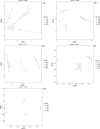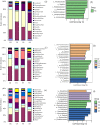Saline and alkaline stresses alter soil properties and composition and structure of gene-based nitrifier and denitrifier communities in a calcareous desert soil
- PMID: 34521348
- PMCID: PMC8442331
- DOI: 10.1186/s12866-021-02313-z
Saline and alkaline stresses alter soil properties and composition and structure of gene-based nitrifier and denitrifier communities in a calcareous desert soil
Abstract
Background: Saline and alkaline stresses damages the health of soil systems. Meanwhile, little is known about how saline or alkaline stress affects soil nitrifier and denitrifier communities. Therefore, we compared the responses of gene-based nitrifier and denitrifier communities to chloride (CS), sulfate (SS), and alkaline (AS) stresses with those in a no-stress control (CK) in pots with a calcareous desert soil.
Results: Compared with CK, saline and alkaline stress decreased potential nitrification rate (PNR) and NO3-N; increased pH, salinity, water content, and NH4-N; and decreased copy numbers of amoA-AOA and amoA-AOB genes but increased those of denitrifier nirS and nosZ genes. Copies of nirK increased in SS and AS but decreased in CS. There were more copies of amoA-AOB than of amoA-AOA and of nirS than of nirK or nosZ. Compared with CK, SS and AS decreased operational taxonomic units (OTUs) of amoA-AOB but increased those of nirS and nosZ, whereas CS decreased nirK OTUs but increased those of nosZ. The numbers of OTUs and amoA-AOB genes were greater than those of amoA-AOA. There were positive linear relations between PNR and amoA-AOA and amoA-AOB copies. Compared with CK, the Chao 1 index of amoA-AOA and amoA-AOB decreased in AS, that of nirK increased in CS and SS, but that of nirS and nosZ increased in all treatments. The Shannon index of amoA-AOB decreased but that of nirS increased in CS and SS, whereas the index of nirK decreased in all treatments. Saline and alkaline stress greatly affected the structure of nitrifier and denitrifier communities and decreased potential biomarkers of nirS-type; however, AS increased those of nirK- and nosZ-type, and SS decreased those of nosZ-type. Soil water content, pH, and salinity were important in shaping amoA-AOA and denitrifier communities, whereas soil water and pH were important to amoA-AOB communities.
Conclusion: These results indicate that the nitrifier and denitrifier communities respond to saline and alkaline stresses conditions. Communities of amoA-AOA and amoA-AOB contribute to nitrification in alluvial gray desert soil, and those of nirS are more important in denitrification than those of nirK or nosZ.
Keywords: Alkaline stresses; Bacterial community diversity; Chloride stress; High-throughput sequencing; Potential nitrification rate; Sulfate stress.
© 2021. The Author(s).
Conflict of interest statement
No potential conflict of interest was reported by the authors.
Figures









References
-
- Wicke B, Smeets E, Dornburg V, Vashev B, Gaiser T, Turkenburg W, Faaij A. The global technical and economic potential of bioenergy from salt-affected soils. Energy Environ Sci. 2011;4(8):2669–2681. doi: 10.1039/C1EE01029H. - DOI
-
- Wu YP, Li YF, Zheng CY, Zhang YF, Sun ZJ. Organic amendment application influence soil organism abundance in saline alkali soil. Eur J Soil Biol. 2013;54:32–40. doi: 10.1016/j.ejsobi.2012.10.006. - DOI
-
- Shi DC, Yin LJ. Difference between salt (NaCl) and alkaline (Na2CO3) stresses on Puccinellia tenuiflora (Griseb.) Scribn et Merr. plants. Acta Bot Sin. 1993;35:144–149.
Publication types
MeSH terms
Substances
LinkOut - more resources
Full Text Sources
Research Materials

